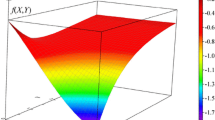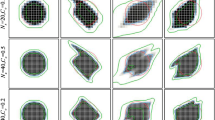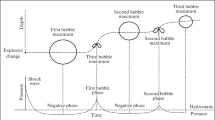Abstract
As well as shock wave and bubble pulse loading, cavitation also has very significant influences on the dynamic response of surface ships and other near-surface marine structures to underwater explosive loadings. In this paper, the acoustic-structure coupling method embedded in ABAQUS is adopted to do numerical analysis of underwater explosion considering cavitation. Both the shape of bulk cavitation region and local cavitation region are obtained, and they are in good agreement with analytical results. The duration of reloading is several times longer than that of a shock wave. In the end, both the single computation and parallel computation of the cavitation effect on the dynamic responses of a full-scale ship are presented, which proved that reloading caused by cavitation is non-ignorable. All these results are helpful in understanding underwater explosion cavitation effects.
Similar content being viewed by others
References
Arons AB (1943). Long range shock propagation in underwater explosion phenomena II. Underwater Explosions Compendium, 1, 10.
Cole RH (1948). Underwater explosion. Princeton University Press, Princeton.
Hakan U (1998). Dynamic response of a catamaran-hull ship subjected to underwater explosions. Naval Postgraduate School, Monterey, California.
Hollyer RS (1959). Direct shock wave damage to merchant ships from non-contact underwater explosions. ANAME, 773–784. https://www.sharcnet.ca/Software/Abaqus/6.11.2/books/stm/default.htm. Coupled acoustic-structural medium analysis. March 27th, 2012.
Hunter KS (2001). Global-shape-function models of an underwater explosions bubble. University of Colorado, Colorado.
Keil AH (1961).The response of ships to underwater explosions. Transactions of Society of Naval Architects and Marine Engineers, 69, 366–410.
Lloyd H, Raphael G (2000). Structural response of submerged air-backed plates by experimental and numerical analyses. Shock and Vibration, 7, 333–341.
Makinen K (1998). Cavitation models for structures excited by a plane shock wave. Journal of Fluids and Structures, 12, 85–101.
Marcus MH (1983). The response of a cylindrical shell to bulk cavitation loading. NSWC TR, 81–295.
Michael M (1978). Explosion effects and properties: Part II Explosion Effects in the Water. AD-A056694.
Rajendran (2008). Reloading effects on plane plates subjected to non-contact underwater explosion. Journal of Materials Processing Technology, 206, 275–281.
Shin YS (1996). Naval ship-shock design and analysis. Course Notes for Underwater Shock Analysis, Naval Postgraduate School, Monterey, California.
Stevent LW (1998). Cavitation effects on a ship-like box structure subjected to an underwater explosion. Naval Postgraduate School, Monterey, California.
Van Aanhold JE (1998). Underwater shock response analysis of a floating vessel. Shock and Vibration, 5, 53–59.
Webster KG (2007). Investigation of close proximity underwater explosion effects on a ship-like structure using the multi-material arbitrary Lagrangian Eulerian finite element method. Virginia Polytechnic Institute and State University, Virginia.
Zamyshlyayev BV (1973). Dynamic loads in underwater explosion. AD-757183.
Author information
Authors and Affiliations
Corresponding author
Additional information
Foundation item:Supported by the National Natural Science Foundation of China (Grant No. 50921001), National Key Basic Research Special Foundation of China (Grant No. 2010CB832704), Scientific Project for High-tech Ships: Key Technical Research on the Semi-planning Hybrid Fore-body Trimaran, Doctoral Research Foundation of Liaoning Province (Grant No. 20091012).
Zhi Zong was born in 1964, is a professor at Dalian University of Technology. His research interests are hydrodynamics, underwater explosion and fluid-structure interaction. He authored two monographs in English published by Elsevier Science in 2006 and CRC Press in 2009, respectively.
Yanjie Zhao was born in 1988, is currently a graduate student at School of Naval Architecture Engineering in Dalian University of Technology. His research interest is underwater explosion.
Fan Ye was born in 1986, is currently anengineer at Marine Design & Research Institute of China. His research interestsare underwater explosion and marine structure design.
Haitao Li was born in 1976, is currently a lecturer at Dalian University of Technology. His research interests are underwater explosion and fluid-structure coupling method.
Gang Chen was born in 1986, is currently a graduate student at School of Naval Architecture Engineering in Dalian University of Technology. His research interest is underwater explosion.
Rights and permissions
About this article
Cite this article
Zong, Z., Zhao, Y., Ye, F. et al. Parallel computing of the underwater explosion cavitation effects on full-scale ship structures. J. Marine. Sci. Appl. 11, 469–477 (2012). https://doi.org/10.1007/s11804-012-1157-7
Received:
Published:
Issue Date:
DOI: https://doi.org/10.1007/s11804-012-1157-7




